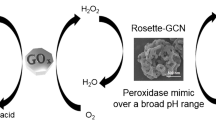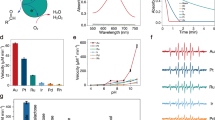Abstract
Four natural nucleotides including 5′-cytidine monophosphate (CMP), 5′-thymidine monophosphate (TMP), guanosine monophosphate (GMP) and 5′-adenosine monophosphate (AMP) were employed to modulate the coordination environment and the valence state of PtCl42−. This is the first report that natural nucleotides have the ability to produce highly active Pt nanoclusters. The latter are shown to act as peroxidase mimetics. Both the size distribution and the charge state of Pt-nucleotide nanozymes vary with the chemical structures of nucleotides, thereby contributing to distinct enzyme-like activities. By adopting Pt-CMP as a signal amplifier, a photometric assay was well-established for quantitative determination of glucose. The assay is based on the oxidation of glucose by glucose oxidase. The oxidation product (H2O2) is detected at 652 nm via the Pt-CMP-catalyzed oxidation of 3,3′,5,5′-tetramethylbenzidine with H2O2. Response is linear in the 5 to 100 μM glucose concentration range, and the limit of detection is 0.12 μM (at S/N= 3). The method excels by a low signal background, high sensitivity, and low consumption of energy and materials.

Peroxidase mimicking Pt nanoclusters were synthesized by employing natural nucleotides as both the reducing agent and the stabilization template.







Similar content being viewed by others
References
Pedone D, Moglianetti M, De Luca E, Bardi G, Pompa PP (2017) Platinum nanoparticles in nanobiomedicine. Chem Soc Rev 46(16):4951–4975. https://doi.org/10.1039/c7cs00152e
Wu J, Li S, Wei H (2018) Integrated nanozymes: facile preparation and biomedical applications. Chem Commun 54(50):6520–6530. https://doi.org/10.1039/C8CC01202D
Loynachan CN, Thomas MR, Gray ER, Richards DA, Kim J, Miller BS, Brookes JC, Agarwal S, Chudasama V, McKendry RA, Stevens MM (2018) Platinum Nanocatalyst amplification: redefining the gold standard for lateral flow immunoassays with Ultrabroad dynamic range. ACS Nano 12(1):279–288. https://doi.org/10.1021/acsnano.7b06229
Nasir M, Nawaz MH, Latif U, Yaqub M, Hayat A, Rahim A (2016) An overview on enzyme-mimicking nanomaterials for use in electrochemical and optical assays. Microchim Acta 184(2):323–342. https://doi.org/10.1007/s00604-016-2036-8
Wu J, Qin K, Yuan D, Tan J, Qin L, Zhang X, Wei H (2018) Rational Design of au@ Pt multibranched nanostructures as bifunctional Nanozymes. ACS Appl Mater Interfaces 10(15):12954–12959. https://doi.org/10.1021/acsami.7b17945
Gao Z, Ye H, Tang D, Tao J, Habibi S, Minerick A, Tang D, Xia X (2017) Platinum-decorated gold nanoparticles with dual functionalities for ultrasensitive colorimetric in vitro diagnostics. Nano Lett 17(9):5572–5579. https://doi.org/10.1021/acs.nanolett.7b02385
Li H, Liu H, Zhang J, Cheng Y, Zhang C, Fei X, Xian Y (2017) Platinum nanoparticle encapsulated metal-organic frameworks for colorimetric measurement and facile removal of mercury (II). ACS Appl Mater Interfaces 9(46):40716–40725. https://doi.org/10.1021/acsami.7b13695
Ge C, Wu R, Chong Y, Fang G, Jiang X, Pan Y, Chen C, Yin JJ (2018) Synthesis of Pt hollow Nanodendrites with enhanced peroxidase-like activity against bacterial infections: implication for wound healing. Adv Funct Mater 28:1801484. https://doi.org/10.1002/adfm.201801484
Li W, Chen B, Zhang H, Sun Y, Wang J, Zhang J, Fu Y (2015) BSA-stabilized Pt nanozyme for peroxidase mimetics and its application on colorimetric detection of mercury (II) ions. Biosens Bioelectron 66:251–258. https://doi.org/10.1016/j.bios.2014.11.032
Henam PS, Heikham FD, Henam SD (2018) Sustainable synthesis of Ultrasmall biogenic platinum nanoparticles for selective aqueous phase conversion of glucose and effective hydrogen peroxide decomposition. Ind Eng Chem Res 57(14):5190–5194. https://doi.org/10.1021/acs.iecr.7b05347
Sha R, Vishnu N, Badhulika S (2018) Bimetallic Pt-Pd nanostructures supported on MoS2 as an ultra-high performance electrocatalyst for methanol oxidation and nonenzymatic determination of hydrogen peroxide. Microchim Acta 185(8):399. https://doi.org/10.1007/s00604-018-2927-y
Fan J, Yin JJ, Ning B, Wu X, Hu Y, Ferrari M, Anderson GJ, Wei J, Zhao Y, Nie G (2011) Direct evidence for catalase and peroxidase activities of ferritin-platinum nanoparticles. Biomaterials 32(6):1611–1618. https://doi.org/10.1016/j.biomaterials.2010.11.004
Liu Y, Zheng Y, Ding D, Guo R (2017) Switching peroxidase-mimic activity of protein stabilized platinum Nanozymes by sulfide ions: substrate dependence, mechanism, and detection. Langmuir 33(48):13811–13820. https://doi.org/10.1021/acs.langmuir.7b03430
Fu Y, Zhao X, Zhang J, Li W (2014) DNA-based platinum Nanozymes for peroxidase mimetics. J Phys Chem C 118(31):18116–18125. https://doi.org/10.1021/jp503242e
Li W, Zhang H, Zhang J, Fu Y (2015) Synthesis and sensing application of glutathione-capped platinum nanoparticles. Anal Methods 7(11):4464–4471. https://doi.org/10.1039/c5ay00365b
Jin L, Meng Z, Zhang Y, Cai S, Zhang Z, Li C, Shang L, Shen Y (2017) Ultrasmall Pt nanoclusters as robust peroxidase mimics for colorimetric detection of glucose in human serum. ACS Appl Mater Interfaces 9(11):10027–10033. https://doi.org/10.1021/acsami.7b01616
Deng HH, Lin XL, Liu YH, Li KL, Zhuang QQ, Peng HP, Liu AL, Xia XH, Chen W (2017) Chitosan-stabilized platinum nanoparticles as effective oxidase mimics for colorimetric detection of acid phosphatase. Nanoscale 9(29):10292–10300. https://doi.org/10.1039/c7nr03399k
Pu F, Ju E, Ren J, Qu X (2014) Multiconfigurable logic gates based on fluorescence switching in adaptive coordination polymer nanoparticles. Adv Mater 26(7):1111–1117. https://doi.org/10.1002/adma.201304109
Zeng HH, Qiu WB, Zhang L, Liang RP, Qiu JD (2016) Lanthanide coordination polymer nanoparticles as an excellent artificial peroxidase for hydrogen peroxide detection. Anal Chem 88(12):6342–6348. https://doi.org/10.1021/acs.analchem.6b00630
Liang H, Zhang Z, Yuan Q, Liu J (2015) Self-healing metal-coordinated hydrogels using nucleotide ligands. Chem Commun 51(82):15196–15199. https://doi.org/10.1039/c5cc06824j
An J, Geib SJ, Rosi NL (2009) Cation-triggered drug release from a porous zinc-adeninate metal-organic framework. J Am Chem Soc 131(24):8376–8377. https://doi.org/10.1021/ja902972w
Azhar MR, Vijay P, Tade MO, Sun H, Wang S (2018) Submicron sized water-stable metal organic framework (bio-MOF-11) for catalytic degradation of pharmaceuticals and personal care products. Chemosphere 196:105–114. https://doi.org/10.1016/j.chemosphere.2017.12.164
Saravanan RK, Saha P, Venkatesh V, Gopakumar TG, Verma S (2017) Coordination-controlled one-dimensional molecular chains in Hexapodal adenine-silver ultrathin films. Inorg Chem 56(7):3976–3982. https://doi.org/10.1021/acs.inorgchem.6b03090
Sharma B, Mahata A, Mandani S, Sarma TK, Pathak B (2016) Coordination polymer hydrogels through ag (I)-mediated spontaneous self-assembly of unsubstituted nucleobases and their antimicrobial activity. RSC Adv 6(67):62968–62973. https://doi.org/10.1039/c6ra11137h
Datta LP, Chatterjee A, Acharya K, De P, Das M (2017) Enzyme responsive nucleotide functionalized silver nanoparticles with effective antimicrobial and anticancer activity. New J Chem 41(4):1538–1548. https://doi.org/10.1039/c6nj02955h
Nagapradeep N, Venkatesh V, Tripathi SK, Verma S (2014) Guanine-copper coordination polymers: crystal analysis and application as thin film precursors. Dalton Trans 43(4):1744–1752. https://doi.org/10.1039/c3dt52415a
Amo-Ochoa P, Alexandre SS, Hribesh S, Galindo MA, Castillo O, Gomez-Garcia CJ, Pike AR, Soler JM, Houlton A, Zamora F, Harrington RW, Clegg W (2013) Coordination chemistry of 6-thioguanine derivatives with cobalt: toward formation of electrical conductive one-dimensional coordination polymers. Inorg Chem 52(9):5290–5299. https://doi.org/10.1021/ic400237h
Hu Y, Xie D, Wu Y, Lin N, Song A, Hao J (2017) Hydrogels based on ag+-modulated assembly of 5′-adenosine monophosphate for enriching biomolecules. Chem Eur J 23(62):15721–15728. https://doi.org/10.1002/chem.201703180
Liang H, Lin F, Zhang Z, Liu B, Jiang S, Yuan Q, Liu J (2017) Multicopper laccase mimicking Nanozymes with nucleotides as ligands. ACS Appl Mater Interfaces 9(2):1352–1360. https://doi.org/10.1021/acsami.6b15124
Zou T, Han Y, Li X, Li W, Zhang J, Fu Y (2019) Unexpected catalytic activity of Pd (II)-coordinated nucleotides in hydrogenation reduction. Colloids Surf A Physicochem Eng Asp 560:344–351. https://doi.org/10.1016/j.colsurfa.2018.10.034
Berti L, Burley GA (2008) Nucleic acid and nucleotide-mediated synthesis of inorganic nanoparticles. Nat Nanotechnol 3(2):81–87. https://doi.org/10.1038/nnano.2007.460
Banyay M, Sarkar M, Gräslund A (2003) A library of IR bands of nucleic acids in solution. Biophys Chem 104(2):477–488. https://doi.org/10.1016/s0301-4622(03)00035-8
Hou T, Zhao T, Li W, Li F, Gai P (2017) A label-free visual platform for self-correcting logic gate construction and sensitive biosensing based on enzyme-mimetic coordination polymer nanoparticles. J Mater Chem B 5(24):4607–4613. https://doi.org/10.1039/c7tb00791d
Dai S, Zhang J, Fu Y, Li W (2018) Biothiol-mediated synthesis of Pt nanoparticles on graphene nanoplates and their application in methanol electrooxidation. J Mater Sci 53(1):423–434. https://doi.org/10.1007/s10853-017-1508-5
Wu J, Fu Y, He Z, Han Y, Zheng L, Zhang J, Li W (2012) Growth mechanisms of fluorescent silver clusters regulated by polymorphic DNA templates: a DFT study. J Phys Chem B 116(5):1655–1665. https://doi.org/10.1021/jp206251v
Acknowledgements
This study was funded by National Natural Science Foundation of China (21878225, 21776215).
Author information
Authors and Affiliations
Corresponding author
Ethics declarations
The author(s) declare that they have no competing interests.
Additional information
Publisher’s note
Springer Nature remains neutral with regard to jurisdictional claims in published maps and institutional affiliations.
Electronic supplementary material
ESM 1
(DOCX 2.63 mb)
Rights and permissions
About this article
Cite this article
Wang, G., Feng, L., Li, W. et al. In-situ generation of nanozymes by natural nucleotides: a biocatalytic label for quantitative determination of hydrogen peroxide and glucose. Microchim Acta 186, 514 (2019). https://doi.org/10.1007/s00604-019-3616-1
Received:
Accepted:
Published:
DOI: https://doi.org/10.1007/s00604-019-3616-1




